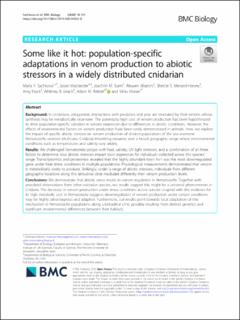| dc.contributor.author | Sachkova, Maria | |
| dc.contributor.author | Macrander, Jason | |
| dc.contributor.author | Surm, Joachim M. | |
| dc.contributor.author | Aharoni, Reuven | |
| dc.contributor.author | Menard-Harvey, Shelcie S. | |
| dc.contributor.author | Klock, Amy | |
| dc.contributor.author | Leach, Whitney B. | |
| dc.contributor.author | Reitzel, Adam M. | |
| dc.contributor.author | Moran, Yehu | |
| dc.date.accessioned | 2021-04-20T10:33:39Z | |
| dc.date.available | 2021-04-20T10:33:39Z | |
| dc.date.created | 2020-09-26T17:59:09Z | |
| dc.date.issued | 2020-09 | |
| dc.Published | BMC Biology. 2020, 18:121 1-13. | en_US |
| dc.identifier.issn | 1741-7007 | |
| dc.identifier.uri | https://hdl.handle.net/11250/2738611 | |
| dc.description.abstract | Background: In cnidarians, antagonistic interactions with predators and prey are mediated by their venom, whose synthesis may be metabolically expensive. The potentially high cost of venom production has been hypothesized to drive population-specific variation in venom expression due to differences in abiotic conditions. However, the effects of environmental factors on venom production have been rarely demonstrated in animals. Here, we explore the impact of specific abiotic stresses on venom production of distinct populations of the sea anemone Nematostella vectensis (Actiniaria, Cnidaria) inhabiting estuaries over a broad geographic range where environmental conditions such as temperatures and salinity vary widely.
Results: We challenged Nematostella polyps with heat, salinity, UV light stressors, and a combination of all three factors to determine how abiotic stressors impact toxin expression for individuals collected across this species’ range. Transcriptomics and proteomics revealed that the highly abundant toxin Nv1 was the most downregulated gene under heat stress conditions in multiple populations. Physiological measurements demonstrated that venom is metabolically costly to produce. Strikingly, under a range of abiotic stressors, individuals from different geographic locations along this latitudinal cline modulate differently their venom production levels.
Conclusions: We demonstrate that abiotic stress results in venom regulation in Nematostella. Together with anecdotal observations from other cnidarian species, our results suggest this might be a universal phenomenon in Cnidaria. The decrease in venom production under stress conditions across species coupled with the evidence for its high metabolic cost in Nematostella suggests downregulation of venom production under certain conditions may be highly advantageous and adaptive. Furthermore, our results point towards local adaptation of this mechanism in Nematostella populations along a latitudinal cline, possibly resulting from distinct genetics and significant environmental differences between their habitats. | en_US |
| dc.language.iso | eng | en_US |
| dc.rights | Navngivelse 4.0 Internasjonal | * |
| dc.rights.uri | http://creativecommons.org/licenses/by/4.0/deed.no | * |
| dc.title | Some like it hot: population-specific adaptations in venom production to abiotic stressors in a widely distributed cnidarian | en_US |
| dc.type | Journal article | en_US |
| dc.type | Peer reviewed | en_US |
| dc.description.version | publishedVersion | en_US |
| dc.rights.holder | Copyright The Author(s) | en_US |
| dc.source.articlenumber | 121 (2020) | en_US |
| cristin.ispublished | true | |
| cristin.fulltext | original | |
| cristin.qualitycode | 2 | |
| dc.identifier.doi | 10.1186/s12915-020-00855-8 | |
| dc.identifier.cristin | 1833785 | |
| dc.source.journal | BMC Biology | en_US |
| dc.source.40 | 18:121 | en_US |
| dc.source.pagenumber | 1-13 | en_US |
| dc.identifier.citation | BMC Biology. 2020, 18, 121. | |

